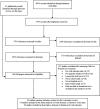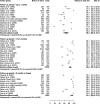Absence from work and return to work in people with back pain: a systematic review and meta-analysis
- PMID: 24186944
- PMCID: PMC4033140
- DOI: 10.1136/oemed-2013-101571
Absence from work and return to work in people with back pain: a systematic review and meta-analysis
Abstract
Background: A considerable proportion of work absence is attributed to back pain, however prospective studies in working populations with back pain are variable in setting and design, and a quantitative summary of current evidence is lacking.
Objective: To investigate the extent to which differences in setting, country, sampling procedures and methods for data collection are responsible for variation in estimates of work absence and return to work.
Methods: Systematic searches of seven bibliographic databases. Inclusion criteria were: adults in paid employment, with back pain, work absence or return to work during follow-up had been reported. Random effects meta-analysis and meta-regression analysis was carried out to provide summary estimates of work absence and return to work rates.
Results: 45 studies were identified for inclusion in the review; 34 were included in the meta-analysis. The pooled estimate for the occurrence of work absence in workers with back pain was 15.5% (95% CI 9.8% to 23.6%, n=17 studies, I(2) 98.1%) in studies with follow-up periods of ≤6 months. The pooled estimate for the proportion of people with back pain returning to work was 68.2% (95% CI 54.8% to 79.1%, n=13, I(2) 99.2%), 85.6% (95% CI 78.2% to 90.7%, n=13, I(2) 98.7%) and 93.3% (95% CI 84.0% to 94.7%, n=10, I(2) 99%), at 1 month, 1-6 months and ≥6 months, respectively. Differences in setting, risk of participation bias and method of assessing work absence explained some of the heterogeneity.
Conclusions: Pooled estimates suggest high return to work rates, with wide variation in estimates of return to work only partly explained by a priori defined study-level variables. The estimated 32% not back at work at 1 month are at a crucial point for intervention to prevent long term work absence.
Figures



Comment in
-
Return to work with back pain: balancing the benefits of work against the efforts of being productive.Occup Environ Med. 2014 Jun;71(6):383-4. doi: 10.1136/oemed-2013-101940. Epub 2014 Apr 15. Occup Environ Med. 2014. PMID: 24737551 No abstract available.
References
-
- Hoy D, Bain C, Williams G, et al. A systematic review of the global prevalence of low back pain. Arthritis Rheum 2012;64:2028. - PubMed
-
- Hoy D, Brooks P, Blyth F, et al. The epidemiology of low back pain. Best Pract Res Cl Rh 2010;24:769–81 - PubMed
-
- Mody GM, Brooks PM. Improving musculoskeletal health: global issues. Best Pract Res Cl Rh 2012;26:237–49 - PubMed
-
- Bevan S, Quadrello T, McGee R, et al. Fit for work? Musculoskeletal disorders in the European workforce (2012). The Work Foundation Report
-
- Widanarko B, Less S, Stevenson M, et al. Prevalence of work-related risk factors for reduced activities and absenteeism due to low back symptoms. Appl Ergon 2012;43:727–37 - PubMed
Publication types
MeSH terms
Grants and funding
LinkOut - more resources
Full Text Sources
Other Literature Sources
Molecular Biology Databases
